gidge348
Senior Member
  
Joined: September 2010
Posts: 426 
|
Post by gidge348 on Aug 12, 2015 6:52:21 GMT -5
I don´t think my idea with the proximity sensor RPM reading will work, the ignition seems to upset the panel gauge so the numbers makes no sense. The tacho generator is still there so I think I´ll use that one instead, after a quick googling I found some information about it and realized that a simple frequency counter might work. "%RPM indicator instruments usually conform to a common standard. The instrument indicates 100% when fed with an AC signal measuring 70 Hz in frequency. A two pole tacho-generator turning at 4,200 rpm will produce this signal. It is normally arranged inside the engine gearbox so that the tacho-generator is driven at 4,200 rpm when the engine is operating at maximum speed i.e. 100%.
Certain older engines may use other gear ratios and instrument calibrations, it is important to always be clear about the actual and indicated speeds of any running gas turbine. It is useful if possible to check a tachometer-generator and indicator instrument combination when removed from the engine. An electric motor can be used to rotate the tacho-generator at a particular know speed and the indicator reading noted. The drive to the tacho-generator on the engine can be examined and the speed ratio determined, this is achieved by rotating the main engine shaft slowly and watching for movement of the tacho-generator drive.
There are many other electrical tachometer systems, one simple system consists of a single phase tacho-generator and an AC volt meter. The EMF (electro motive force) produced by the tacho-generator is directly proportional to the rotational speed of the generator, as the speed doubles the voltage doubles. The generator output voltage can be measured with a simple low current moving coil meter and rectifier, the meter is calibrated in RPM."If I understand this correctly I could simply use a frequency meter coupled to the tacho generator to measure RPM, right? To make sure I´ll remove the generator from the gearbox and measure the gearing ratio to see that it´ll reach 4200rpm at 100% engine speed. Cheers! /Anders Yep you could use a frequency meter but an easier option may be that if it is like the nimbus tach generator it will have just 3 pins and if you can get a 3 pin %gauge from eBay etc, just hook them up, no need for external power. If when you run it up that %gauge seems to run backwards swap any 2 of the wires over and it should work. Some later % gauge's have lots of pins for all sorts of other stuff, you do not want one of those. Cheers Ian... |
|
|
|
Post by Johansson on Aug 12, 2015 17:04:15 GMT -5
Easier yes but the ones I´ve found will cost me a couple of hundred euros after shipping and taxes are payed, so that will have to wait until the hobby account has filled up some after this summers workshop expansion.
A simple frequency meter will be perfect for now, thanks for confirming it.
|
|
gidge348
Senior Member
  
Joined: September 2010
Posts: 426 
|
Post by gidge348 on Aug 14, 2015 1:43:08 GMT -5
Yep, I have noticed that the prices on flea bay are getting a bit over the top I think the last ones I bought were about $20au each.
|
|
|
|
Post by Johansson on Aug 15, 2015 16:47:10 GMT -5
I checked the gear ratio of the tacho generator drive just now and after some punching of numbers the frequency at max rpm turned out to be exactly 70Hz, a relief to know that it works like it should.  Now I have a Hz value for both idle and full throttle so that will work perfectly, in the shelves I have a programmable frequency counter where I can set the 0-70Hz span as 0-100 to get a percentage reading of the revs if I feel the need for it later. Cheers! /Anders |
|
|
|
Post by Johansson on Aug 18, 2015 16:37:06 GMT -5
I hooked the tacho generator up tonight, great to have a reliable RPM reading. 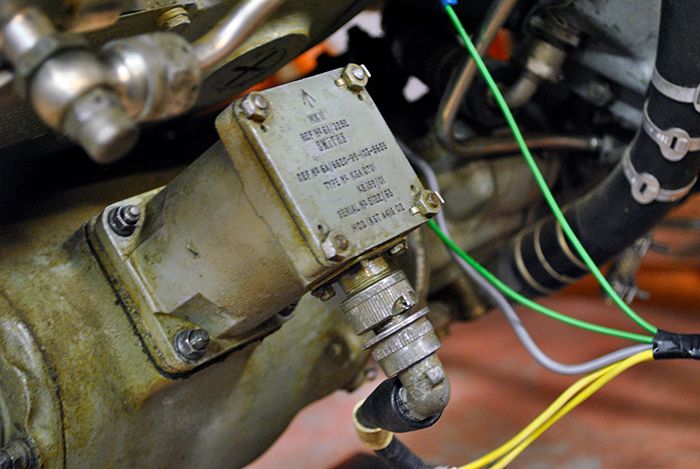 As you can see the idle "rpm" is 7.7Hz, knowing that will make me a bit less nervous during the first start attempt. Without any way of knowing if idle has been reached the risk of a hung start is much greater. 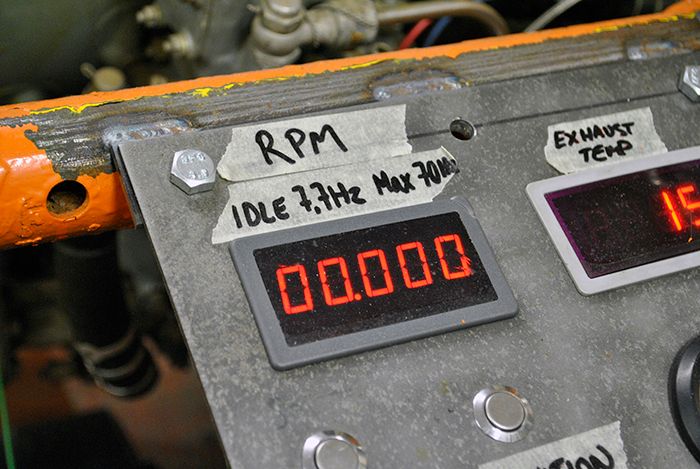 I´ve also disassembled the 12-24V battery selector to fit a manual stop for the knob so it cannot be turned all the way to the 1+2 position where it shorts out the batteries. 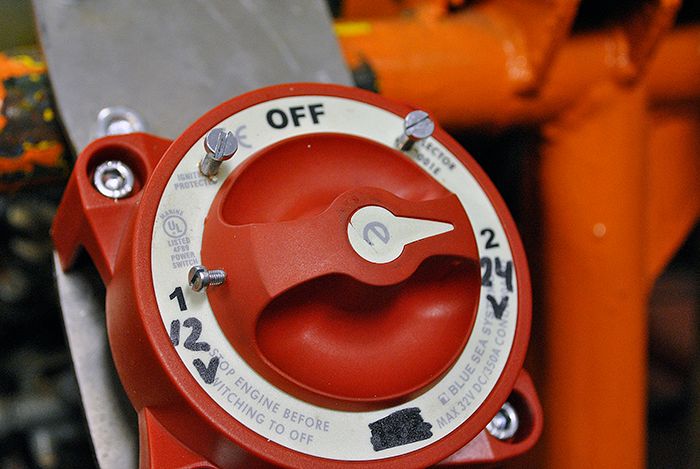 Cheers! /Anders |
|
|
|
Post by ernie wrenn on Aug 22, 2015 10:28:47 GMT -5
Interesting way to do a soft start... Good Idea..
|
|
|
|
Post by Johansson on Aug 22, 2015 14:47:43 GMT -5
Thanks, I hope it will work.
|
|
|
|
Post by Johansson on Aug 30, 2015 16:26:28 GMT -5
The last couple of days I´ve been finishing off the wiring and today I went and borrowed a pair of sturdy cranking batteries from Olov, I don´t feel like spending lots of cash on a pair of new ones without knowing if the engine even will start. 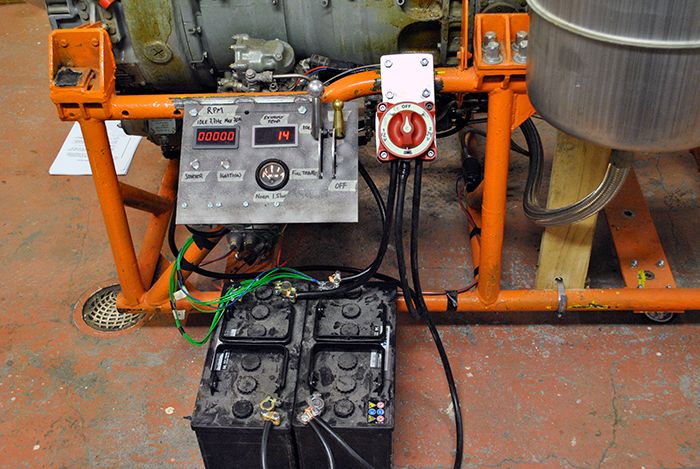 To get some more room for the Viper I moved the turbine bike and some other stuff out to the cold side of the workshop, finally some space to move around in the workshop again!   Time to fill some oil! 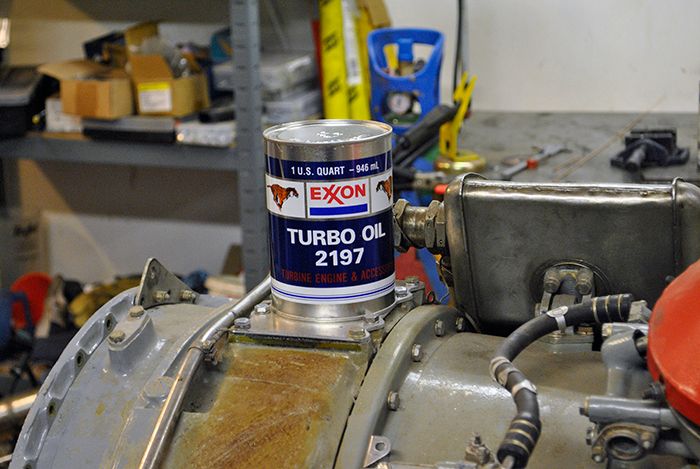 According to the manual there are two priming connections on the oil lines from the micro pumps to the middle and rear rotor bearing, a priming connection on the return oil filter and an oil level plug on the accessory gearbox. I primed the oil lines and filter and filled oil in the gearbox until it came out of the oil level plug.  If anyone who reads this know about more priming locations or other things that needs to be done before running a Viper after long time storage please let me know ASAP.  The batteries were more or less dead so I am charging them over night, they had enough in them to let me turn the engine over on 12V to see that everything seemed ok. Cheers! /Anders |
|
|
|
Post by Johansson on Sept 1, 2015 11:31:36 GMT -5
Today the batteries were charged so I went outside with my youngest daughter to test the 12V starter, it worked like a charm but I kind of forgot to check the starter temp and toasted it during the third attempt to get the rev counter to work... I can hardly blame the starter since I ran it on 24V for almost a minute in total without much time to cool down, it cost 80 USD plus shipping so I don´t think it will be cheaper to send it away for rewinding. I´ll order two of them next time so I have room for another f*ckup later.  Cheers! /Anders |
|
|
|
Post by racket on Sept 1, 2015 17:12:06 GMT -5
Hi Anders
Heh heh , you need to add a bit of fuel to help the batteries and starter ;-)
Cheers
John
|
|
rythmnbls
Veteran Member
  
Joined: August 2011
Posts: 145
|
Post by rythmnbls on Sept 1, 2015 20:21:12 GMT -5
Love the sound of the loose comp blades as it spools down, RB211's do the same thing.
Steve.
|
|
gidge348
Senior Member
  
Joined: September 2010
Posts: 426 
|
Post by gidge348 on Sept 1, 2015 20:44:15 GMT -5
Hi Anders, top job thanks for posting, I was wondering if when the starter cooled down did it come back to life or did it totally fry up? I thought you were going to run the switch as the start circuit and was wondering how it would handle the inrush of amps, but I see you have those start relays in there. Do you have 2 of them in parallel or is one running the 12v and 1 running the 24v???. 24v 150A doesn't seem big enough for all that power? Do you think it is worth putting in some kind of thermal cut out in there to protect the starter or just keep it simple and not run as much next time??  Cheers Ian... |
|
|
|
Post by Johansson on Sept 2, 2015 2:30:24 GMT -5
Hi Anders Heh heh , you need to add a bit of fuel to help the batteries and starter ;-) Cheers John Indeed, at least I know that the starter is up for the job. Hi Anders, top job thanks for posting, I was wondering if when the starter cooled down did it come back to life or did it totally fry up? I thought you were going to run the switch as the start circuit and was wondering how it would handle the inrush of amps, but I see you have those start relays in there. Do you have 2 of them in parallel or is one running the 12v and 1 running the 24v???. 24v 150A doesn't seem big enough for all that power? Do you think it is worth putting in some kind of thermal cut out in there to protect the starter or just keep it simple and not run as much next time??  Cheers Ian... Unfortunately I think it is toast, it let go of a puff of smoke and died so I must have burned out the windings. I have two relays in parallel so a total of 300A, according the guy I bought them from the relays are very moderately labeled so they can take much more amperage for a shorter period of time. A simple temp probe strapped to the starter housing will do, as John said once the fuel ignites the heat helps the starter to bring it up to idle revs so with a cold start motor I don´t think there will be any problem at all. Cheers! /Anders |
|
gidge348
Senior Member
  
Joined: September 2010
Posts: 426 
|
Post by gidge348 on Sept 3, 2015 21:00:43 GMT -5
Bugga that magic smoke will get you every time  |
|
|
|
Post by Johansson on Sept 3, 2015 22:56:56 GMT -5
Lucky me that I didn´t pay more for the starter, imagine if I had bought a genuine Viper starter for 2000 USD or so...
|
|














